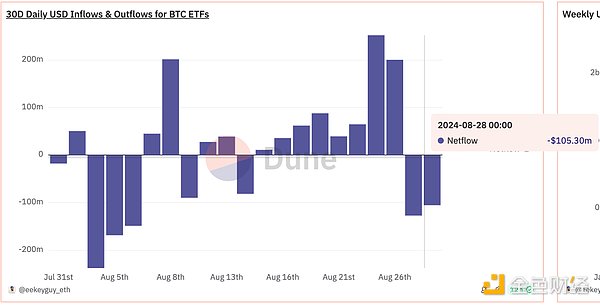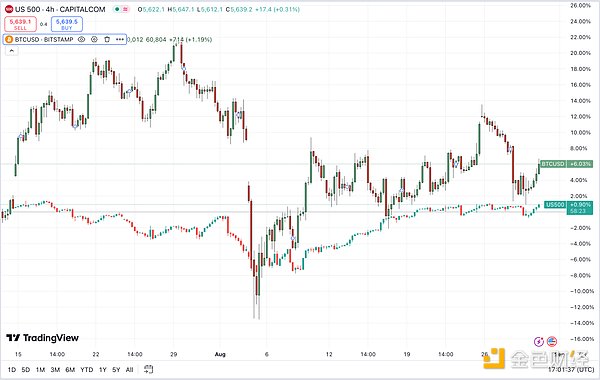Author: Revc, Golden Finance
Foreword
If the financial market is compared to an AI model with huge data and sample size, then the main component factors affecting the trend of US stocks and crypto assets in the model are the monetary policy that the Federal Reserve is about to adjust. Powell recently said at the Jackson Hole Conference that the time has come to adjust monetary policy. Prior to this, the minutes of the July meeting of the Federal Open Market Committee (FOMC) released by the Federal Reserve showed that most Federal Reserve officials strongly preferred to decide to cut interest rates at the September meeting.
While the financial market is holding its breath waiting for interest rate adjustments, where will the crypto market go? We try to find the answer from the recent performance of US stocks and ETFs.
Recent Performance of US Stocks
This week's US stock market data and events reflect investors' confidence in economic recovery, but at the same time remain cautious about expectations for future policies and market volatility. The Conference Board Consumer Confidence Index for August, released on Tuesday, rose for the second consecutive month to 103.3, indicating that consumers' optimism about the economy has increased, which may indicate an increase in consumer spending. However, although Nvidia's second-quarter earnings report exceeded expectations, the market reaction was not satisfactory, showing that investors' expectations for technology stocks were already high, and the earnings report was good but did not bring new surprises. The specific performance was that the market performed mediocrely in the first three trading days of this week, and the correction intensified. At the time of writing this article, the fourth trading day rebounded by nearly 1%, as shown in the figure below. Market sentiment turned from optimism at the beginning of the week to caution. Despite optimistic economic data and the Dow Jones Industrial Average hitting a new record high, the performance of the Nasdaq and S&P 500 shows concerns about technology stocks and overall market volatility. Investors are adjusting their positions and looking for new investment opportunities, and the market's reliance on technology stocks may be decreasing. The decline in US stocks may trigger a series of reactions, which may eventually lead to looser monetary policy and fiscal stimulus. Readers can pay attention to the possibility of a 50 bp interest rate cut at the September interest rate meeting. Recession concerns Macquarie analysts recently released a report expressing concerns about the outlook for the US economy. If the Federal Reserve does not cut interest rates soon, the possibility of the US economy falling into recession will greatly increase. The report is based on the following:
Weak labor market: The latest consumer confidence report shows some worrying signs in the US job market, such as a decline in the proportion of respondents who believe that job opportunities are abundant, while the proportion of respondents who believe that jobs are hard to find has increased.
Other economic indicators are not good: Indicators such as hiring and resignation rates also show a weak trend, similar to the levels during the 2015-2017 period.
Market expectations: Investors generally expect the Federal Reserve to cut interest rates by a large amount of 99 basis points before the end of the year.
The weakness in the labor market will lead to a rise in unemployment, which will in turn drag down economic growth. In contrast, the European Central Bank has a relatively hawkish attitude as it focuses on controlling inflation. This divergence in central bank policies has led to the recent weakness of the US dollar, but Macquarie believes that this trend may be coming to an end.
ETFRecent Performance
This week's performance and fundamental analysis of Bitcoin spot ETFs show the complexity of market sentiment. In terms of fund flows, Bitcoin ETFs experienced a shift from net inflows to net outflows this week. The net inflows accumulated for eight consecutive days reached 756 million US dollars, but net outflows began to appear on Tuesday, with a net outflow of 105 million US dollars yesterday, indicating that market sentiment may be changing and investors are adjusting their positions. Despite the outflows, the net asset ratio of Bitcoin ETFs remained at 4.64% (market value to the total market value of Bitcoin), reflecting the persistence of long-term confidence in Bitcoin. Meanwhile, Ethereum spot ETFs have experienced net outflows for nine consecutive days, showing that the market has low interest in Ethereum.

From the perspective of market sentiment and analysis, investors remain cautious about the short-term volatility of Bitcoin, but are optimistic about the future/Institutional movements such as BlackRock's Bitcoin ETF (IBIT) have shown strong capital inflows, showing recognition of Bitcoin as an asset class. Despite the net outflow of funds in the short term, in the long run,ETF's asset size and institutional investor participation show that there is still confidence in the long-term value and potential of Bitcoin, and the market is looking for a suitable entry point.
Latest news on the Bank of Japan's interest rate hike
The previous yen interest rate hike caused a flash crash in the financial market, and the crypto market was not immune. Investors should also pay attention to the Bank of Japan's actions.
Recent remarks by Bank of Japan Deputy Governor Yoshizo Himino and President Kazuo Ueda both indicate that the Bank of Japan will consider further interest rate hikes if the economic and price prospects continue to improve.This position not only strengthens the market's expectations for future interest rate hikes, but also hints at the possible direction of policy adjustments, reflecting confidence in economic recovery and the need to adjust easing policies.
In addition, the Bank of Japan's interest rate hike expectations and actual interest rate hikes will have a significant impact on the financial market. First, as an important investor in overseas assets, Japan's interest rate hikes have led to higher domestic yields, reduced demand for foreign assets, and prompted the sale of existing assets, which in turn affected global financial liquidity. Secondly, the yen strengthened amid expectations of rate hikes, showing the market's sensitivity to policy changes, especially against the backdrop of the Fed's expectations of rate cuts, the yen's attributes as a safe-haven currency are more prominent. In addition, the Bank of Japan's policy adjustments are related to the Fed's policy direction, which may have a complex impact on global markets. Analysts expect that if the Bank of Japan's confidence in the economic cycle increases, it may raise interest rates by 25 basis points every 6 months in the future, and it is expected that the annual interest rate may reach 0.75% or higher by 2025, marking a major shift in Japan's monetary policy.
Recent Performance of Crypto Market
Crypto market sentiment showed uncertainty and volatility this week, and investor confidence was affected by the macroeconomic environment, such as the Fed's policy adjustments and global economic turmoil. These factors have led to a reduction in large capital inflows, affected market liquidity, and changed investor behavior from long-term holding to short-term and frequent trading, showing the market's preference for quick profits and PVP patterns. The regulatory environment has also had a significant impact on the crypto market. The interest rate hikes and regulations in the previous cycle restricted the entry of incremental funds and increased market volatility. Although the top crypto assets have performed well in the technology and developer communities, market demand has not kept up, possibly due to different expectations for future policies and economic environments. The market decline before and after the rate cut is considered normal, but the market rebound has not been fully realized because the liquidity injection did not meet expectations, showing that although retail investors are active, they lack the impetus of large funds, and the overall market performance is weak.
Correlation between US stocks and crypto markets
At the beginning of the year, due to the jump in crypto assets, they were non-correlated and negatively correlated with US stocks, but after April, the correlation was restored to a certain extent, and the focus of the crypto market shifted from Bitcoin halving to the expectation of rate cuts.
As shown in the figure below, although the US stock market fell this week, the impact on the cryptocurrency market was not completely consistent. The performance of the cryptocurrency market has its own logic, which is affected by the US stock market but not completely synchronized.

The correlation between Bitcoin and the S&P 500 can be attributed to factors such as falling inflation and the Fed's pause in rate hikes, creating a favorable environment for risk-on trading. Despite the correction, both have seen a bullish rebound recently due to expectations of rate cuts.
When Bitcoin's correlation with traditional stock markets increases and its correlation with gold decreases, it indicates that Bitcoin is more of a risk-on asset than a safe haven. Investors tend to invest in both stocks and digital currencies when seeking high returns. The increased participation of institutional and retail investors in the stock and cryptocurrency markets, and their joint buying and selling decisions may lead to consistent price movements of these assets, that is, increased correlation.
Summary
The market's expectation for a rate cut in September 2024 has been made clear, which has eased market uncertainty to a certain extent and may drive funds from traditional financial markets to high-yield assets such as cryptocurrencies. However, the expectation of a rate cut has been digested by the market, and the actual implementation may not bring about a sharp rise. Even a rate cut that is lower than expected may lead to market disappointment and affect the trend of crypto assets.
Before and after the rate cut, investor behavior may diverge, with some entering the market in advance to drive prices up, while others wait and see or turn to other assets, increasing market volatility. Rate cuts usually signal an economic downturn, but they also reduce the opportunity cost of holding fixed-income assets, which may prompt funds to flow into the crypto market. Despite the good technical outlook, market demand may be suppressed by the uncertainty of the macro environment. The long-term impact of rate cuts on the market depends on economic recovery and policy continuity.
 Edmund
Edmund







